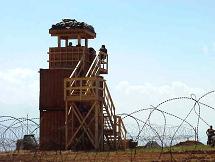Lithuanian Parliamentary Commission Confirms Presence of CIA Prisons

A commission set up by the Lithuanian parliament acknowledged last week that at least two sites had been established inside the country to serve as secret detention camps for the CIA’s “war on terror.”
The parliamentary enquiry into the CIA’s activities in Lithuania commenced its investigations following a US media report in August revealing that the agency had organised a secret facility near the capital of Vilnius. It now emerges that at least two sites were established on Lithuania soil—the first of which was already operational in 2002. This admission by Lithuania parliamentarians is the first official confirmation by a European country that it housed such CIA detention centres.
The prisons in Lithuania belonged to the worldwide gulag of “black sites” run by the CIA to interrogate and torture prisoners. These torture prisons were used to systematically subject those deemed to be terrorist suspects to sleep deprivation, waterboarding and beatings in order to obtain information or extort confessions.
The secret prisons were set up outside of the US by the Bush administration because they blatantly contravened existing American law. The fact that the torture employed by the CIA also violated international law was evidently no deterrent for those countries’ governments, including a number of European nations, which provided facilities for such “black sites.”
From 2003 onwards, the prisons in Lithuania were organised and run from the CIA centre in the German city of Frankfurt-Main, which also had responsibility for similar facilities situated in Romania, Poland and a remote part of Morocco. There have also been allegations that Ukraine also hosted a CIA detention camp.
Earlier this year, the former director of the Frankfurt CIA branch office, Kyle D. Foggo, admitted to the New York Times that the prison facilities had been organised from Frankfurt because “it was too sensitive to be handled by headquarters.”
According to Arvydas Anusauskas, head of the Lithuanian national security and defence committee, the parliamentary commission identified two sites used by the CIA. The first prison had been established in 2002, and the second site was set up in 2004. It is presumed that the Lithuanian authorities agreed to host the prisons in return for Washington’s support for the country’s admission into NATO in 2004.
The head of Lithuania s domestic intelligence agency has resigned following the revelations, and the individual who ran the country’s state security department from June 1998 until April 2004 has also been recalled from his post as Lithuania’s ambassador to Georgia.
Nevertheless, there are indications that the report by the parliamentary commission was aimed at providing political cover for the country’s two presidents during the period in which the prisons were in operation. The Lithuanian defence minister, Rasa Jukneviciene, noted that in the work of the commission, “We did not manage to dot all the i’s….,” and the parliamentary report concludes vaguely that the two presidents were “not informed, or only informed superficially” about the sites.
Responding to the commission’s findings, the current prime minister, Andrius Kubilius, stressed that Lithuania—formerly part of the Stalinist bloc—was determined to remain a close ally of Washington, but then noted that “the strategic partnership with the US cannot be an excuse to essentially operate under Soviet methods, to ignore the civil control of special services and to violate existing laws.”
All the eastern European countries alleged to have housed CIA torture prisons—Lithuania, Poland, Romania and Ukraine—established close links with the US after the collapse of the Soviet Union and the other Stalinist states in 1989-1991. They were all members of the club of east European countries that received considerable political backing from the US—often in the form of “colour revolutions”—and were demonstratively praised by former Secretary of Defence Donald Rumsfeld as the “New Europe.”
At the same time, so-called “Old Europe”—i.e., western European nations such as Great Britain, France, Italy and Germany—were also complicit in illegal CIA operations. Reports first emerged about the CIA’s policy of establishing torture prisons and its criminal practice of kidnapping terror suspects in 2005, and US President George W. Bush admitted the existence of such CIA detention centres for the first time in September 2006.
Prior to that, however, Italian state authorities had cooperated closely with the CIA in the kidnapping of the Egyptian-born Italian citizen Imam Abu Omar in February 2003. Following his abduction in broad daylight on an Italian street, Abu Omar was transported to an Egyptian torture prison.
In two reports published in 2006 and 2007, the president of the Commission for Human Rights for the Council of Europe, Dick Marty, revealed that the CIA had extended its illegal operations across Europe. CIA planes transporting prisoners to a host of its “black sites” in Europe, the Middle East and Africa had been given permission on hundreds of occasions to land at Europe’s leading airports. Marty uncovered the close cooperation between European secret services and the CIA, but met with a wall of silence and denial on the part of the European governments. In the main, European governments had “made little effort” to clarify what had taken place, Marty concluded.
In the meantime, the cover-up of criminal CIA operations is being continued by the Obama administration. At a press briefing December 22, Assistant Secretary of State Phillip J. Crowley repeatedly fobbed off journalist’s questions about the position of the US government with regard to CIA “black sites.” Crowley refused to give any information on the issue and merely referred journalists to the CIA.

